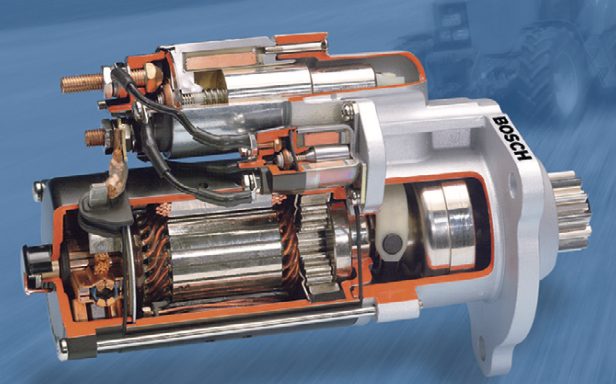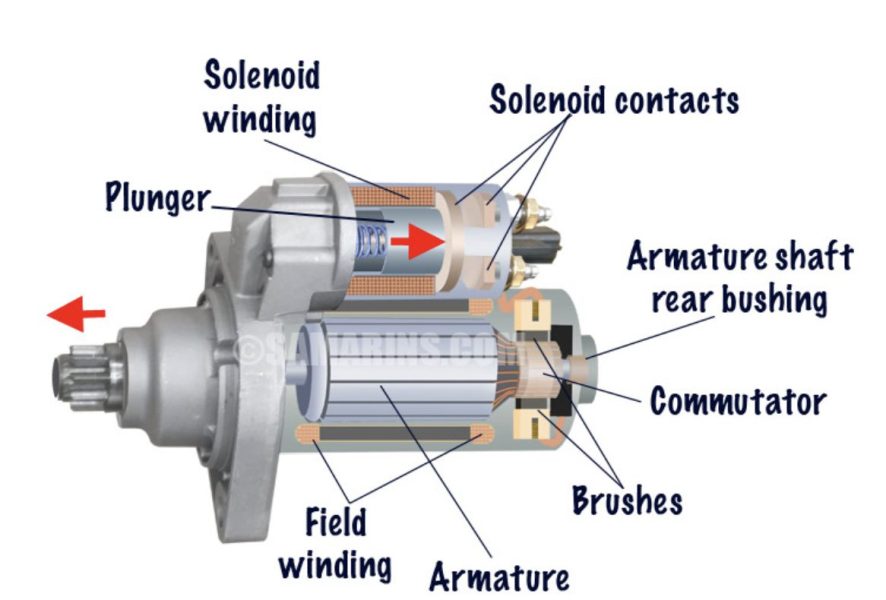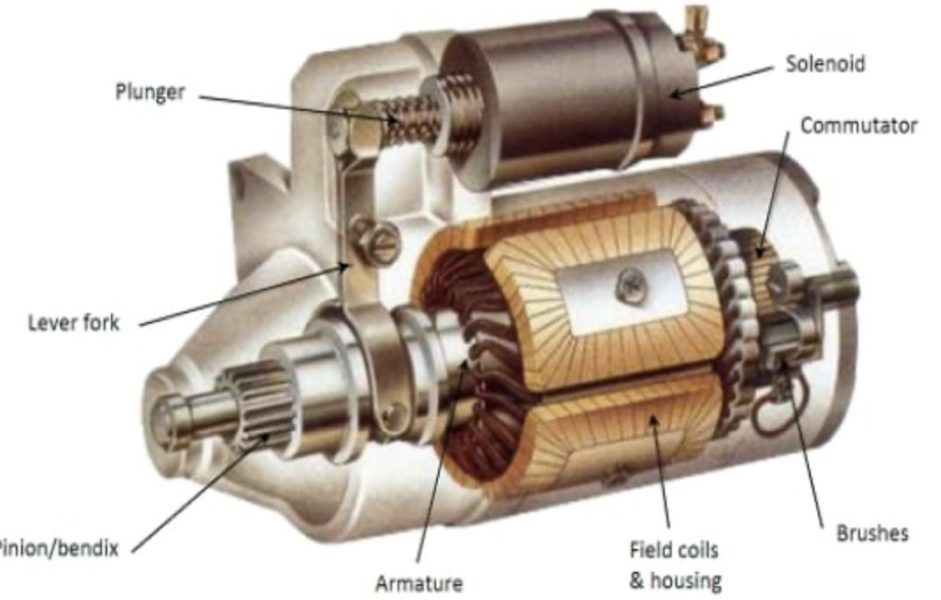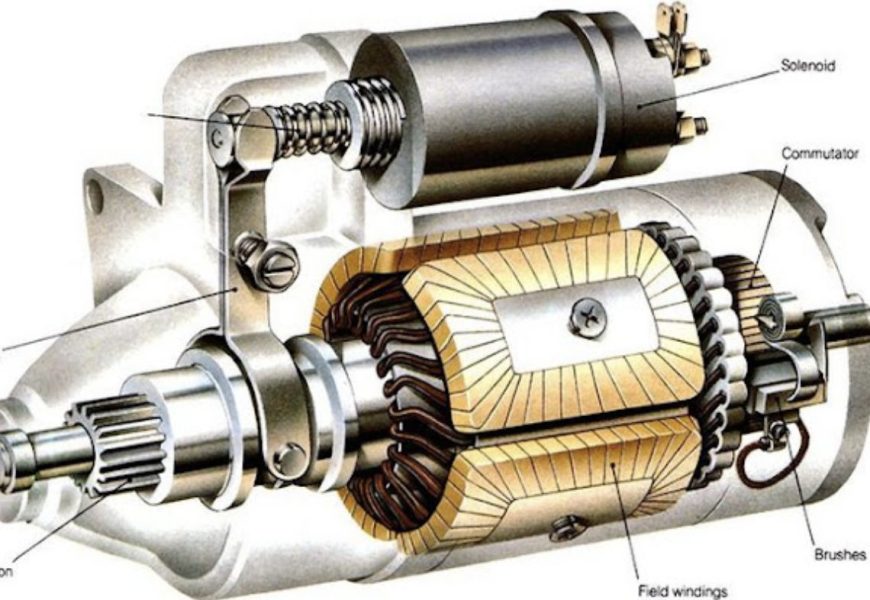When it comes to the internal components of a car, the starter is one of the most critical pieces. The starter is responsible for cranking the engine and starting the car, and without it, the vehicle won’t run. In this blog, we will take a closer look at the internal components of a starter and how they work together to start the car’s engine.

- Armature The armature is the heart of the starter motor, consisting of a wire-wound coil wrapped around an iron core. When electricity flows through the coil, it creates a magnetic field that turns the armature. The armature’s rotation is what cranks the engine, as it turns the flywheel.
- Commutator The commutator is a metal ring with several individual segments, mounted on the armature shaft. The segments connect the armature coils to the brushes, which provide an electrical connection to the battery. The commutator’s job is to switch the direction of the electrical current flowing through the armature, so it continues to rotate in the same direction.
- Brushes Brushes are carbon blocks that press against the commutator to conduct electrical power from the battery to the armature. As the armature spins, the brushes slide across the commutator’s individual segments, changing the current’s direction through the armature. Over time, brushes wear down, and they need to be replaced to keep the starter working correctly.

- Solenoid The solenoid is an electromagnetic switch that sends a large amount of current to the starter motor to crank the engine. It consists of a coil of wire, a plunger, and a set of contacts. When the ignition key is turned, the solenoid’s coil receives power, causing the plunger to move, and the contacts close, sending electricity to the starter motor.
- Drive gear The drive gear is a small gear mounted on the starter motor’s armature shaft. When the ignition key is turned, the solenoid sends power to the starter motor, causing the drive gear to engage with the engine’s flywheel. The gear’s engagement causes the armature to turn, which cranks the engine.
In conclusion, the starter is a crucial component of any vehicle, and its internal components work together to start the engine. Understanding how these components work can help you diagnose starter problems and keep your car running smoothly. Remember to maintain your starter regularly and replace any worn-out components to ensure your car’s reliability.
- Armature The armature is the primary moving component of the starter motor. It is a shaft with a wire-wound coil wrapped around an iron core. When electricity flows through the coil, it creates a magnetic field that turns the armature. The armature’s rotation generates the torque required to crank the engine. The armature’s design is critical for the starter’s performance, and it is often made of high-quality materials to withstand the stress of cranking the engine.
- Commutator The commutator is a metal ring with several individual segments mounted on the armature shaft. The segments connect the armature coils to the brushes, which provide an electrical connection to the battery. The commutator’s role is to switch the direction of the electrical current flowing through the armature, so it continues to rotate in the same direction. The commutator’s design is crucial for ensuring smooth operation and minimizing the risk of electrical arcing, which can damage the starter’s components.
- Brushes Brushes are carbon blocks that press against the commutator to conduct electrical power from the battery to the armature. As the armature spins, the brushes slide across the commutator’s individual segments, changing the current’s direction through the armature. Over time, brushes wear down, and they need to be replaced to keep the starter working correctly. The quality of the brushes is critical for the starter’s performance and longevity, and they should be made of high-quality materials to withstand the stress of operation.
- Solenoid The solenoid is an electromagnetic switch that sends a large amount of current to the starter motor to crank the engine. It consists of a coil of wire, a plunger, and a set of contacts. When the ignition key is turned, the solenoid’s coil receives power, causing the plunger to move, and the contacts close, sending electricity to the starter motor. The solenoid’s design is essential for ensuring reliable operation and minimizing the risk of electrical arcing, which can damage the starter’s components.
- Drive gear The drive gear is a small gear mounted on the starter motor’s armature shaft. When the ignition key is turned, the solenoid sends power to the starter motor, causing the drive gear to engage with the engine’s flywheel. The gear’s engagement causes the armature to turn, which cranks the engine. The drive gear’s design is critical for ensuring smooth engagement with the flywheel and minimizing the risk of damage to the engine or the starter motor.
In summary, the starter’s internal components work together to ensure reliable and efficient engine starting. The armature, commutator, brushes, solenoid, and drive gear all play a critical role in the starter’s operation, and their design is crucial for ensuring performance and longevity. Regular maintenance and inspection can help identify and prevent potential problems, ensuring your vehicle starts reliably every time.

Advantages of Starter Internal Components:
- Efficient engine starting: The starter’s internal components work together to efficiently start the engine, ensuring that the vehicle runs smoothly and reliably.
- Longevity: The high-quality materials used in the starter’s internal components ensure that they can withstand the stresses of operation and last a long time.
- Reliability: The starter’s design and internal components ensure reliable operation, allowing the vehicle to start consistently, even in harsh conditions.
- Maintenance: The starter’s internal components are easily accessible and replaceable, allowing for easy maintenance and repair if any problems arise.

Disadvantages of Starter Internal Components:
- Cost: The high-quality materials used in the starter’s internal components can make them more expensive to manufacture and repair, which can increase the overall cost of the starter.
- Wear and Tear: Over time, the starter’s internal components will experience wear and tear, which can lead to reduced performance and eventually failure. Regular maintenance and inspection can help prevent this.
- Environmental Impact: The manufacture and disposal of starter internal components can have an environmental impact, with the potential for hazardous waste and pollution.
- Complexity: The starter’s internal components can be complex and require specialized knowledge and tools for repair and maintenance, which can make it challenging for non-experts to work on them.
In conclusion, the starter’s internal components have many advantages, including efficient engine starting, longevity, reliability, and easy maintenance. However, they also have some disadvantages, including cost, wear and tear, environmental impact, and complexity. Overall, understanding the starter’s internal components and their role in engine starting can help vehicle owners ensure their vehicles run smoothly and reliably.




